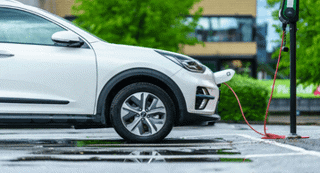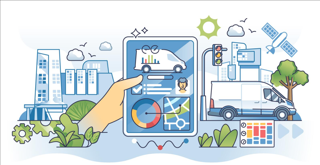The day-to-day management of thousands of fleets could be radically changed with nine out of 10 cars being ‘connected’ by 2020.
Connected cars come with the ability to share data in real-time and, as they become the norm, industry experts are predicting a massive upsurge in aftermarket devices.
No black box will need to be fitted to vehicles and data feeds will simply be switched on to provide a range of services such as maintenance alerts and usage based insurance.
Today, only 10% of new cars come with built-in connectivity, but with numbers set to soar, communications-giant Telefonica says it has the potential to revolutionise the car industry.
Connecting the car
Some manufacturers have already been embracing the potential of connectivity through smartphone applications, but debates about how to connect the car continue.
Whether enabled by a dedicated connection (built-in), as implemented in Renault and Nissan vehicles, smart phone tethering (brought-in), as favoured by Kia, or a combination of both solutions, as favoured by BMW, Audi and Volvo, there are advantages and challenges to each.
Either way, the built-in option will be required for mandated solutions such as eCall, which is due in 2015. Although, as the legislation works its way through the European Commission, to what extent it will finally be implemented, and when, is still unclear.
Nevertheless, it has inherent advantages such as antenna strength, compared to a handset or similar device, located within the vehicle.
An exciting innovation
Brought-in options, such as fleet management systems or sat-nav systems, have addressed the aftersales automotive industry for many years.
However, with the emergence of the connected car, with built-in connectivity, a recent report suggests the aftersales device market is set for a massive sea-change.
Carlos Morales, global machine-to-machine (M2M) director at Telefonica Digital, said: “The connected car is one of the most exciting innovations we have seen in over a century of automotive development.”
The Connected Car Industry Report 2013, which has been commissioned by Telefonica Digital, brings together the views of Audi, BMW, Jaguar Land Rover, Kia, Nissan, Renault, Volvo and General Motors,
It reveals an auto-industry looking for new revenue streams, which is very aware of the technology’s potential to boost their bottom line.
Nicolas Nollet, aftersales strategy director at Renault, told the report’s authors “embedded solutions will deliver return on investment advantages to aftermarket solutions, such as fleet management systems where device purchasing costs may have been prohibitive factors in the past”.
Thousands of fleets will have vehicles with access to data from manufacturers or third party suppliers for the first time, with the potential to substantially cut costs
Changing business models
Existing telematics’ providers recognise the changing landscape means they will have to adapt their business models.
Its rapid success is partly down to it developing and building its own device and using it to target different sectors with the potential to deliver a range of solutions.
However, the company’s commercial director Alan Cottrill told Fleet News he recognised it was only a matter of time before the technology they build will exist in cars at the manufacturing stage.
“Whether they buy our boxes or somebody else’s, we see our business as a solutions business,” added Cottrill. “We’re building solutions that react to data, where that data comes from is immaterial.”
The report also recognises that for the car industry it will require the redefinition of a century-old business model, which has remained largely unchanged for more than a century.
With product lifecycles, payment interactions and customer service being traditionally measured in years, the connected car consumer will require a new service dynamic, more akin to the telecoms industry where such cycles are measured in months.
Service bundles, delivery channels, product pipelines, pricing and customer support will be heavily impacted, it says, and in some cases new business models will need to be created from scratch as the dynamic between manufacturer, fleet and third party providers evolves.
Control will be key
Futurist Ian Pearson said: “Being in control of the operating systems, comms and computing platforms will be a huge advantage and allow a seamless interfacing with additional special features only available to their customer.”
In many ways, the battles will be similar to those between features built into smartphones versus downloadable apps, but in the car there are more opportunities to link to exclusively accessible hardware and sensors.
“This will continue to provide abundant OEM opportunities, but with no room for complacency, since even small weaknesses will readily be exploited by outside companies,” concluded Pearson.





















Login to comment
Comments
No comments have been made yet.